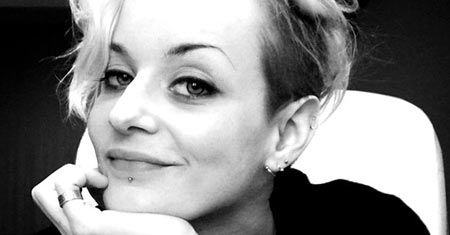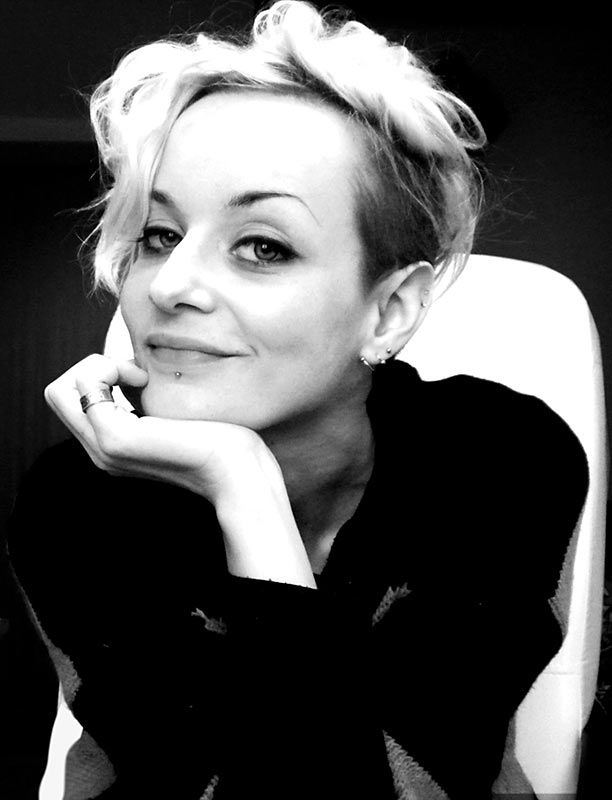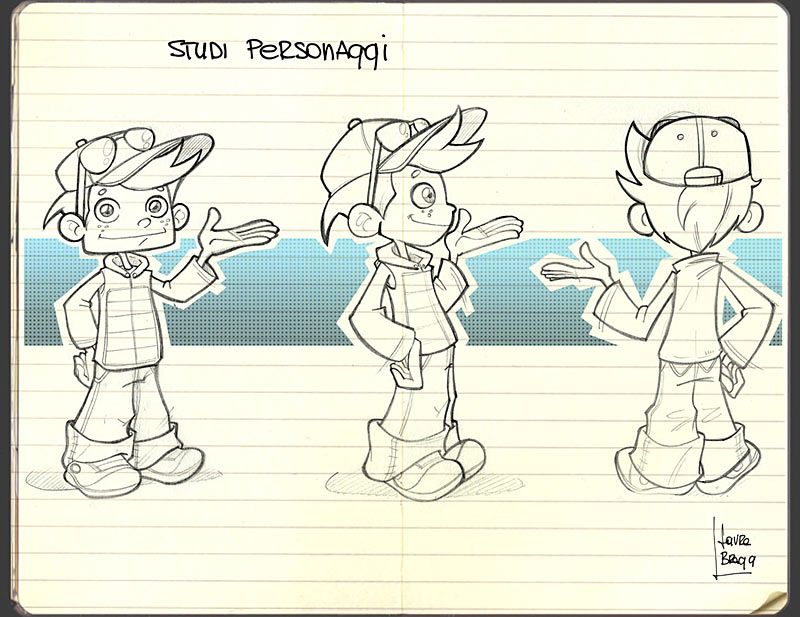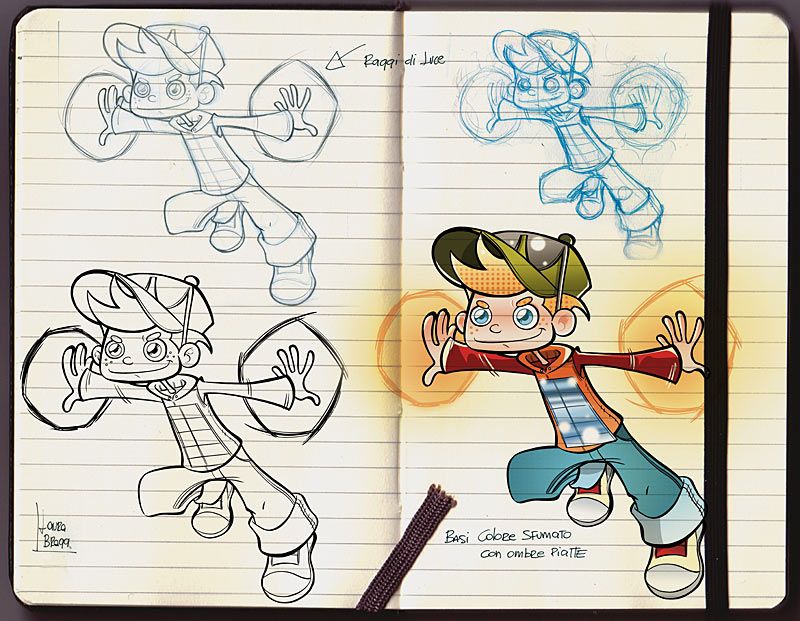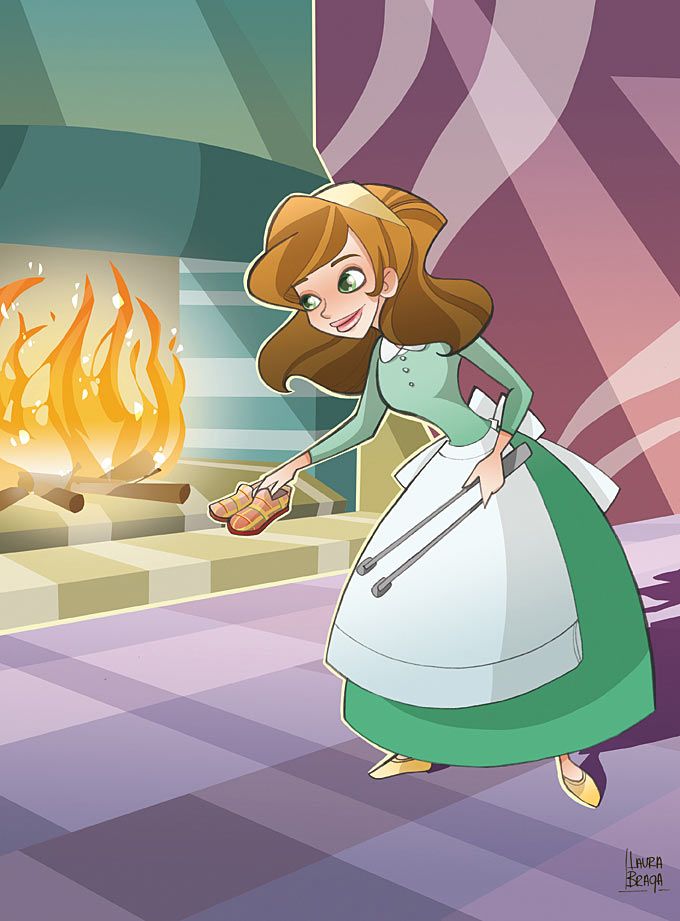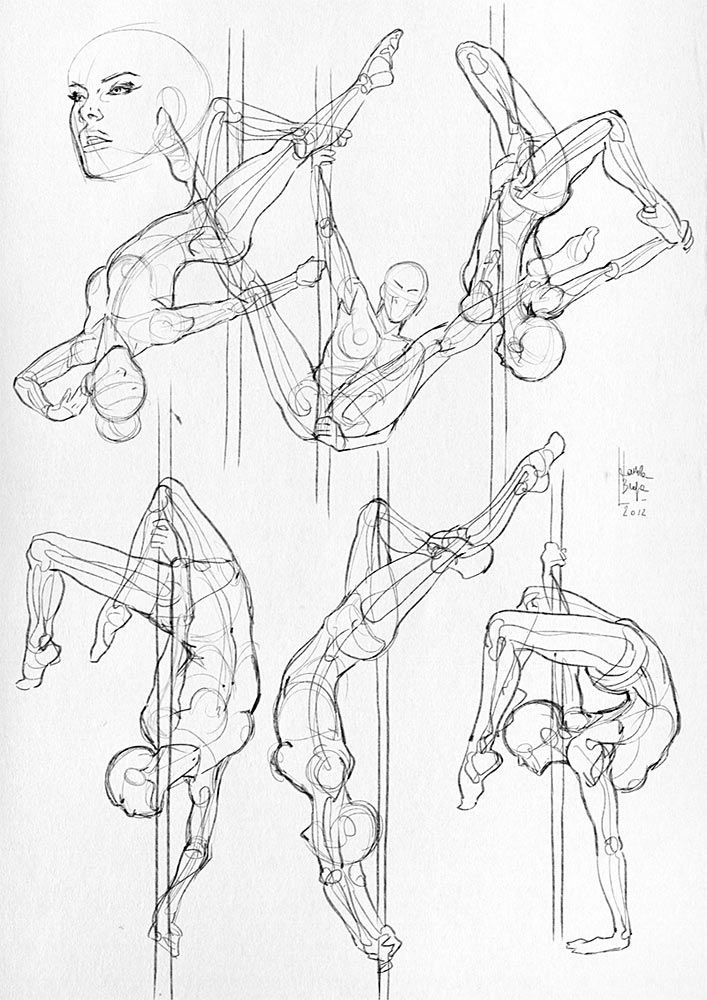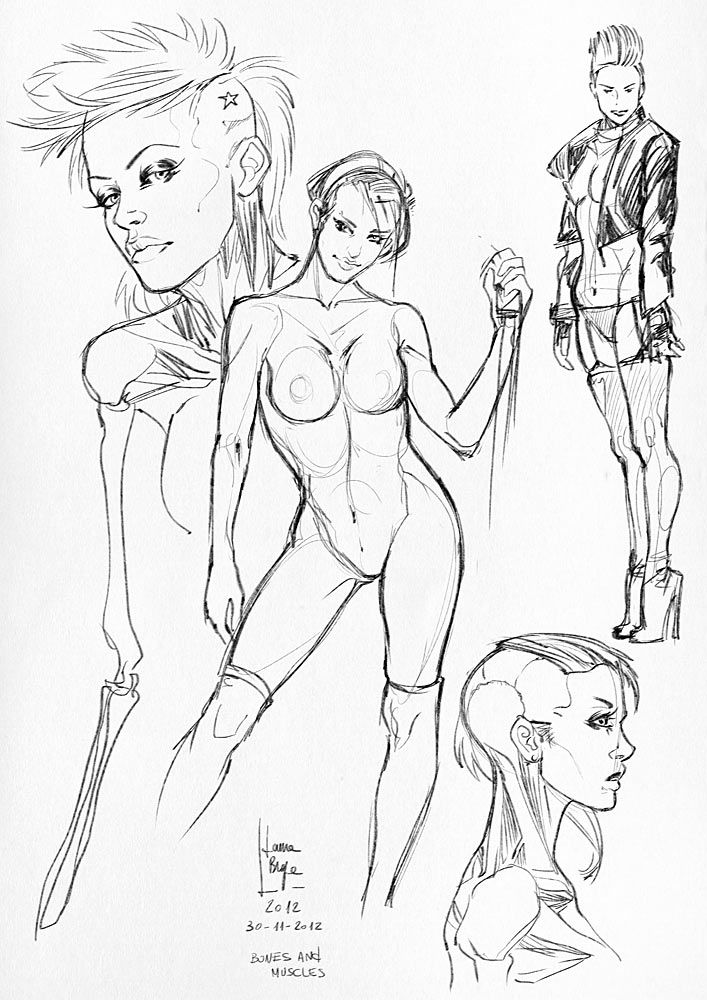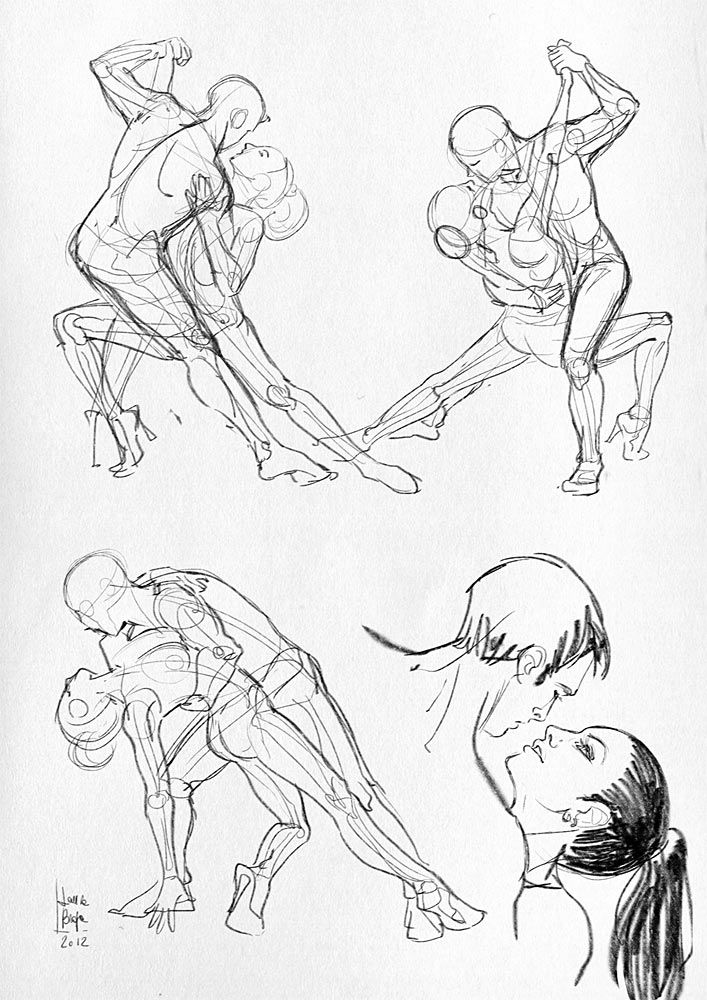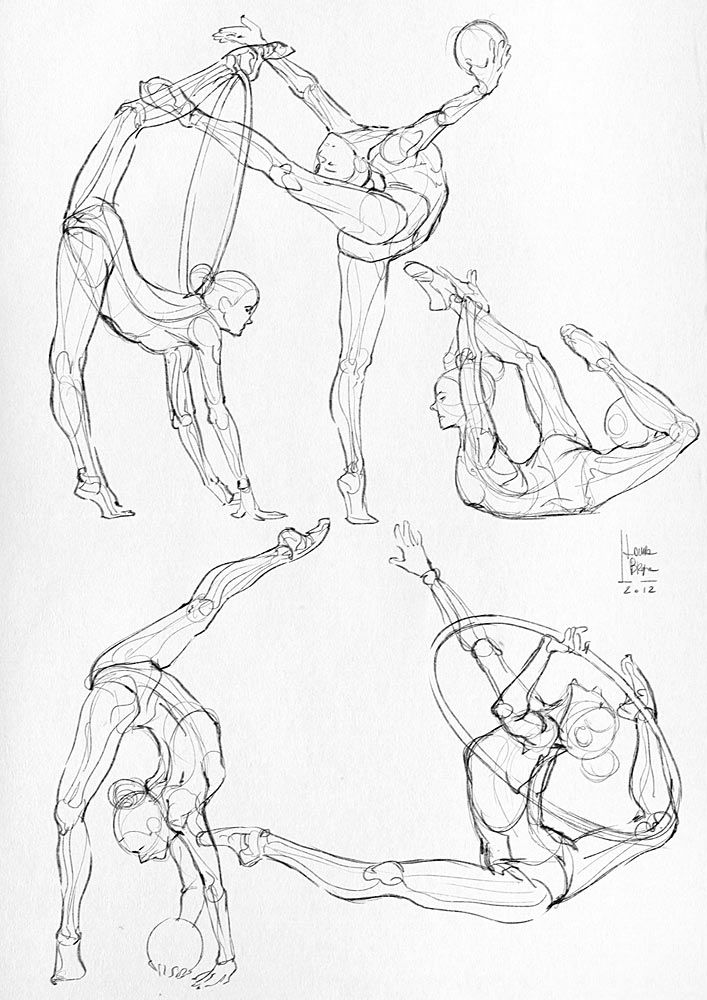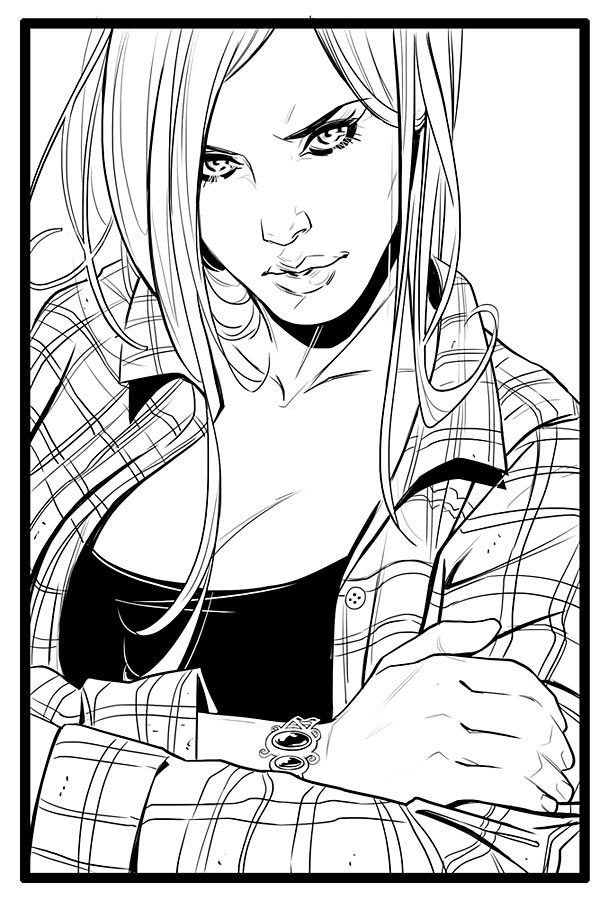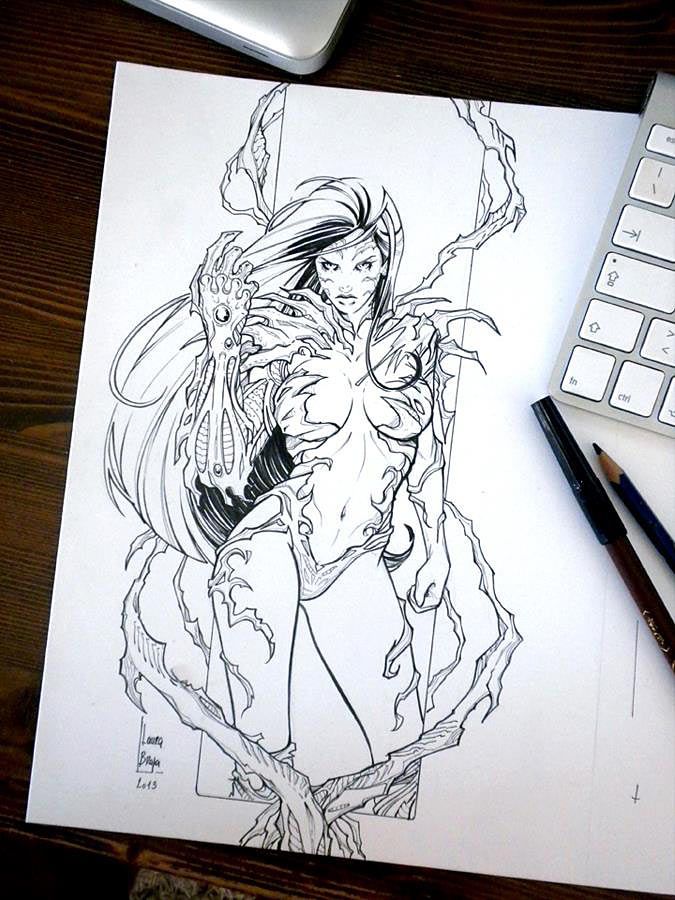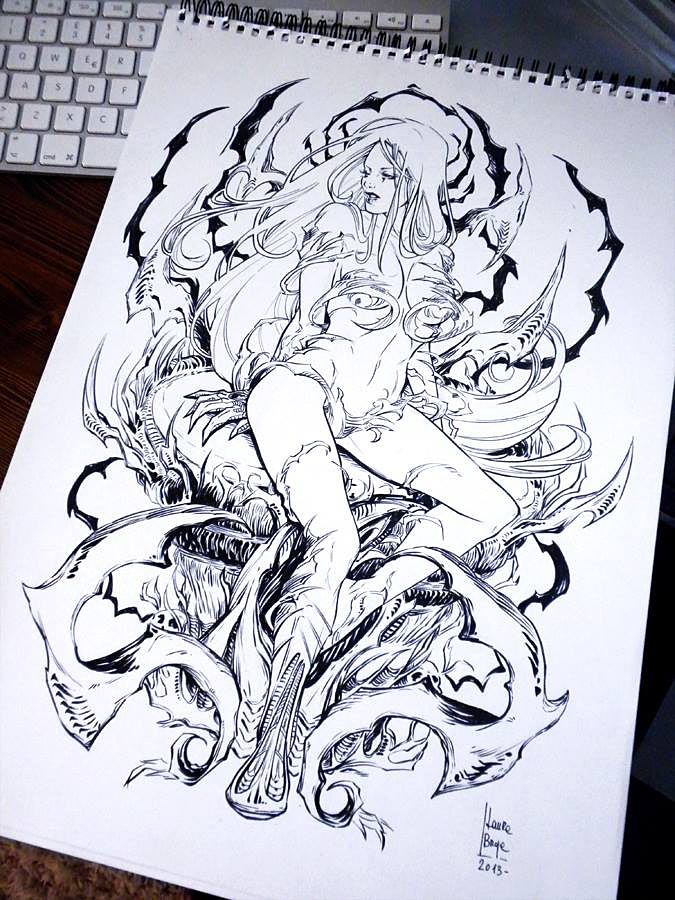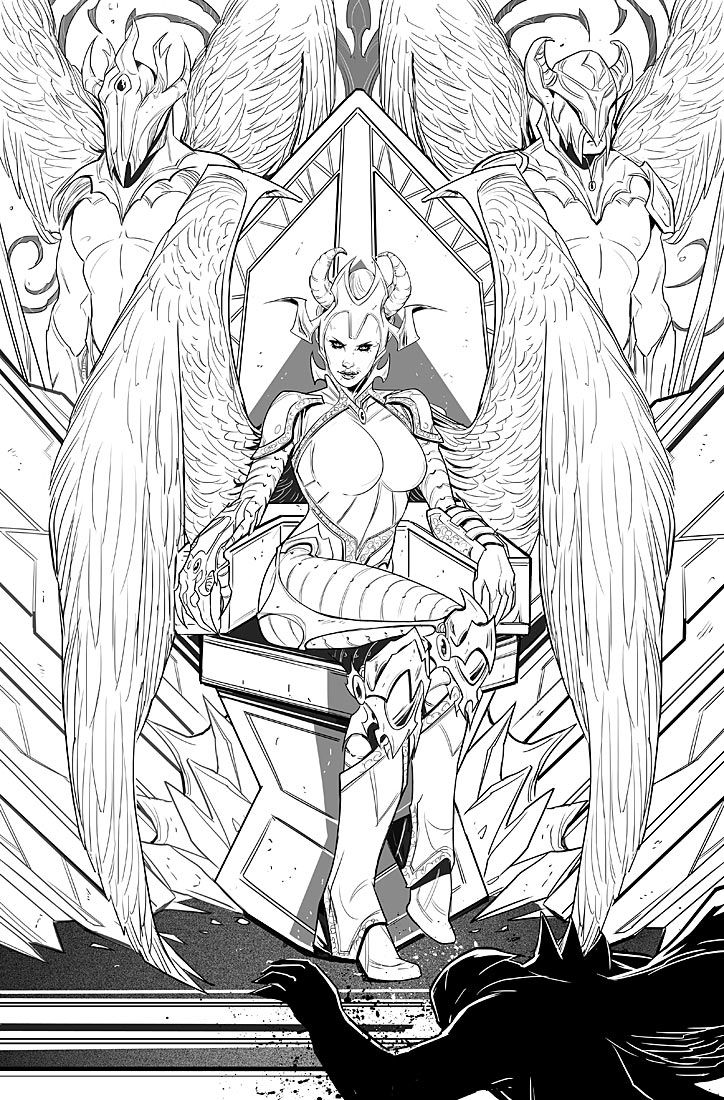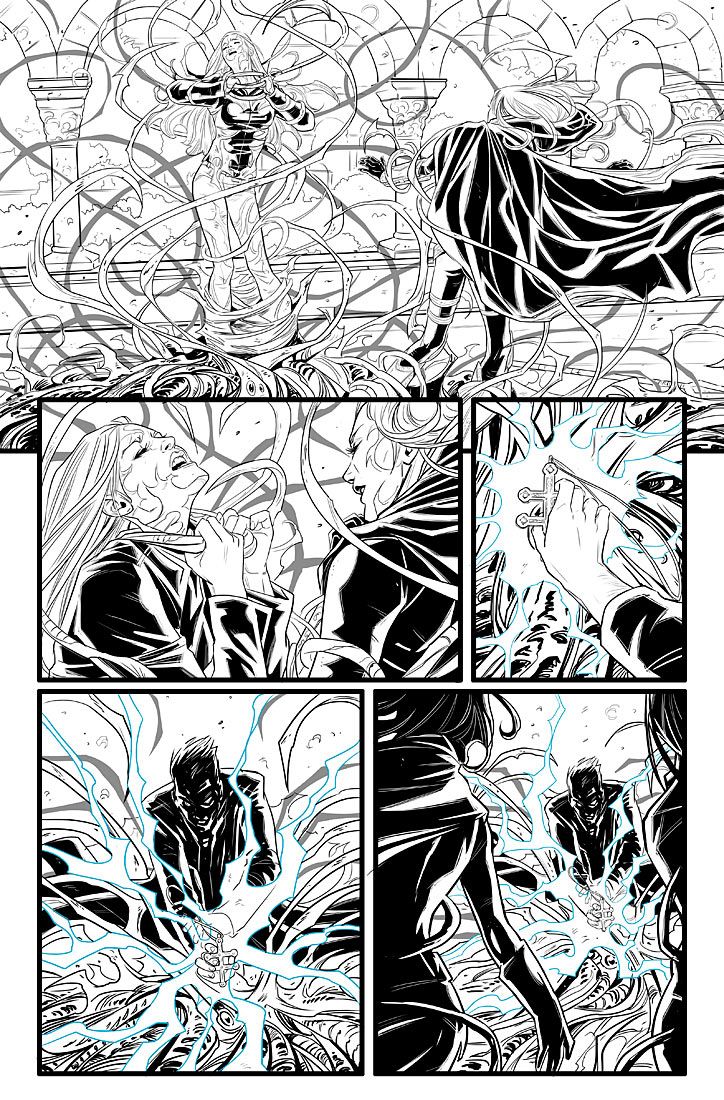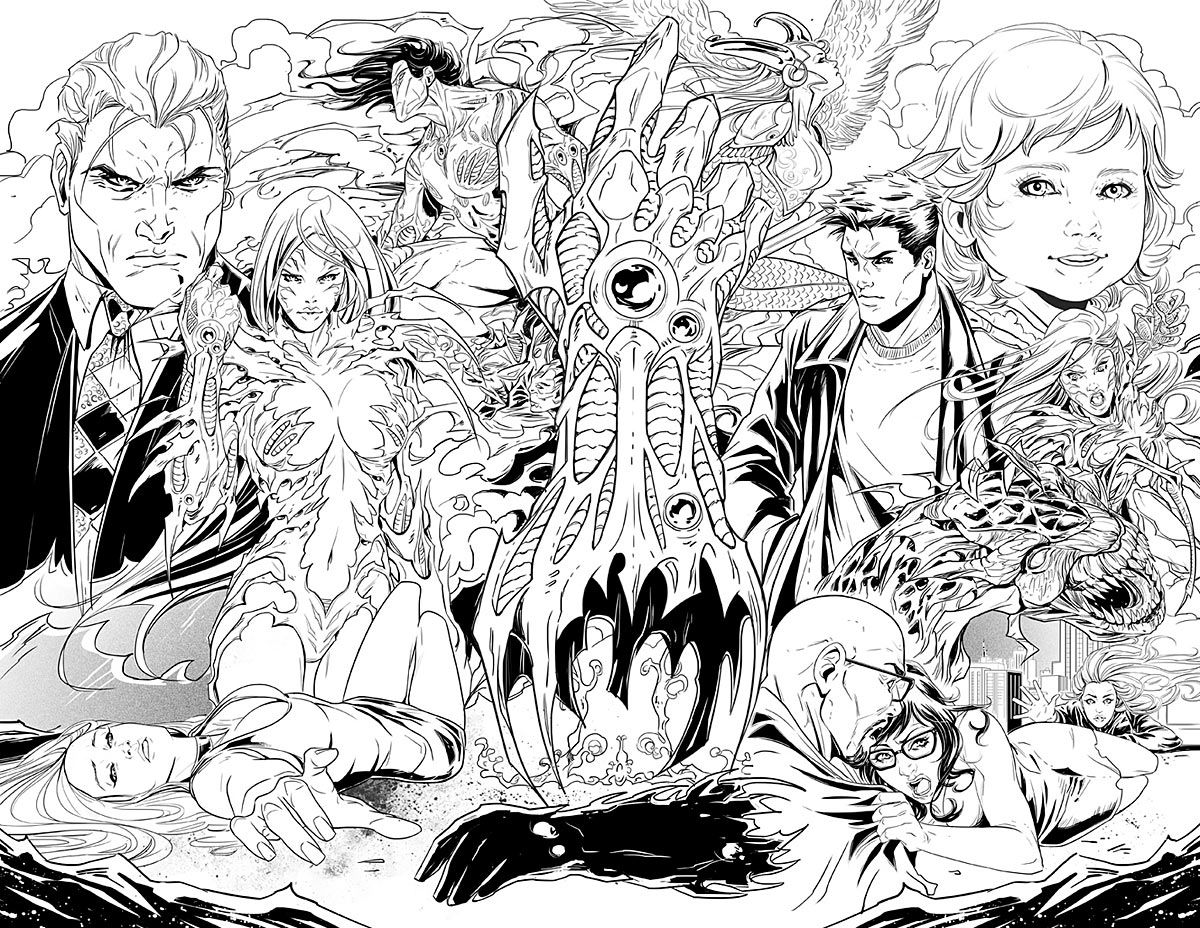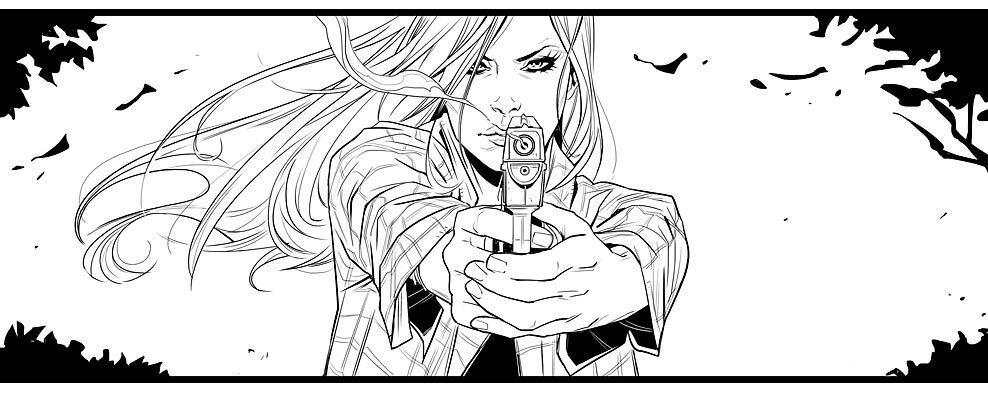Artistic Questions and Answers with Laura Braga
Thank you, Twitter. That's where I first discovered the work of Italian artist Laura Braga. Twitter led me to Laura's site, and I was wholly impressed with what I saw there. We struck up a correspondence, and when I was invited back to the writing duties of "Witchblade," I requested Laura as the artist. Thankfully for everybody involved, Top Cow agreed.
Marz Returns to "Witchblade with an All-New Direction
"Witchblade" #172 was just released yesterday, the third issue together for me and Laura, hopefully the third of many issues together. I'm more impressed with her work -- and more thankful to be working with her -- with each passing issue.
There's an initial "getting to know you phase" when an artist and writer start working together, and it's kind of like dating. You figure out each other's likes and dislikes, what each of you is good at, whether you're ultimately compatible. The fruits of that process can yield all-time great writer/artist teams like Lee and Kirby, Claremont and Byrne, Moore and Gibbons, Miller and Mazzucchelli. I've been fortunate enough to have had long-term partnerships with people like Ron Lim, Darryl Banks, Stjepan Sejic and a few others.
Those kinds of partnerships seem more rare at present. Writer-artist teams on work-for-hire projects don't often stay together long enough to build up that sort of working relationship. More often, artists are swapped on and off assignments in order to keep up with the demands of a monthly schedule and the assembly-line nature of shared-universe titles. That's why books like "Batman" by Snyder and Capullo, and "Daredevil" by Waid and Samnee, are such rare pleasures.
It also seems like artists have less of a voice these days, in that you see far more interviews with writers than their artistic counterparts. It's a disservice to what is, as far as I'm concerned, the more necessary aspect to creating comics. No art, no comic. I've wondered aloud why artists get short shrift, especially in reviews. The reason I've most often heard, from interviewers and reviewers themselves, is that they don't feel they have the artistic vocabulary to adequately discuss the art, so they avoid it. More's the pity.
I've been disappointed that a talent like Laura, new to the U.S. market, hasn't been featured in more interviews. So I did one myself.
Ron Marz: Growing up in Italy, did you always want to be an artist?
Laura Braga: Yes, as far as I can remember, I've always wanted to draw comics or cartoons. As a child I spent lots of time drawing or coloring, it was my favorite game. I always said drawing comics would be my job, and I've grown up keeping that promise.
I know from your bio that you attended the International School of Comics in Florence, the Disney Academy in Milan, and the schools of Comic-Animation at Montimages in Bassens and La Salle. What were those like? Did you want to become an animator at first?
All of them have been very positive and constructive experiences for me, especially because they were very different from each other. As a child, I said that I wanted to draw cartoons. Over the years, and maybe also thanks to the animation course, I realized that I was more keen on comics and illustration.
Did you develop more of an animated style at the Disney Academy?
Certainly my style at the beginning was very similar to Disney cartoons. My earliest work (dating from the early 2000s) was definitely influenced by the Disney Academy, and at the time I worked mainly on books for kids. Even now, actually, I feel like that style still very close to me, I like the idea of being able to do more projects that are very different from each other. I think it's a constructive thing for an artist.
Tell me about working with the great Milo Manara. How did you meet him, what was the collaboration like? Did he help evolve your style to what it is now? I feel like I see some hints of Manara in your work.
I first met Milo Manara in 2005, because at that time we were working for the same publisher. We were put into contact by the publisher. Milo was working on creating characters for a commercial for Argentina, and needed a hand to complete some drawings. Later I worked on the coloring of his "46" book. It was certainly important, because it was the first step that drew me to a more realistic style. After that collaboration, I then started to develop a more realistic style.
You have a husband and a son, right? I know your husband is a composer, so how do both of you balance work and family time.
Yes, my husband is a composer and musician, and we have a 4-year-old little boy, who already says that when he grows up he wants to draw with me, or color my drawings! I think I'm very lucky, because my family is the main source of inspiration for my work. My husband and I both have our studios at home, so in spite of having limited time, and so many things to do, we always manage to find time for the family.
Do you work at home, or do you have a separate studio you go to?
I have a small studio at home, where I can better manage the work.
When I first saw your art, I was especially drawn to all the anatomy studies. I think it's fairly unusual for comic artists to show off work featuring bones and muscle structure. More often, it's a bunch of pin-ups.
Anatomy is a very important element. It's the basis of any illustration, not only for a proper drawing, but mainly to give life to the character. Every movement, every muscle in tension, conveys the emotion of the body, and then of the character.
That's a more classical approach I think a lot of artists could learn from. But your working methods are very contemporary in that you work digitally as well as traditionally. I assume digital likely makes composing pages somewhat easier and faster, but do you have a preference for one over the other?
I have no preference really. I started working on paper with ink and brushes, and I've gone digital only in the last few years. I think both worlds have positive and negative sides. Certainly working digitally helps with the deadlines, but it's also true that working on paper gives me more satisfaction. I think the charm of paper is irreplaceable. I try to work both ways, because in general I don't like the idea of working only in one way or another. I find it a bit limiting.
So let's talk about "Witchblade." You've said you were a fan of the book before we started working on it. What did you like about it?
"Witchblade" was one of the first American comics I read. I approached the series for the beautiful drawings by Michael Turner. I think my love for this series is due in large part to the character of Sara. I loved her from the first issue, such a strong woman, but at the same time fragile. Definitely one of the most interesting female characters in comics.
I felt like you would be a great fit for the "Witchblade" because you draw women that feel very real, whether they're tough or vulnerable or sexy or anything in between. Do you feel like you have a better grasp on that because you're a woman?
Maybe, but it's quite unconscious. I just try to draw the characters, in this case a woman, in a way that fits with the personality and with the mood of the story.
The U.S. comics industry has been wrestling with its acceptance of women in creative roles, and obviously has to do a much better job of it. Is the situation in Europe similar? What's your experience been like being a woman in comics?
As for my personal experience, unfortunately it's not uncommon that judgments are made based on being a woman or a man, rather than by the quality of the work. It happened to me when I was younger, at my first work experience. But it's been over 10 years since then, and I think and hope that the general situation today has changed. Now it's normal to have a woman as an artist, colorist or inker. I like to think that talent has no gender, and that good results depend on commitment and hard work.
I think our first issue together was good, our second issue was better, and our third issue is better yet. I feel like you're raising the level or your art every few pages. Do you have that sense?
I hope that the fourth will be even better, and the fifth and all the next ones! This is definitely very important for me, because I'm never fully satisfied with my work. I always see things that can be improved, so I try to do that in the next issue. I have to also say that the story is really compelling. I'm always curious and excited every time I get the script for a new issue, and I try to make it better.
That's flattering, but I think any comic story is only as good as the artist drawing it. Your side of the job is harder than mine. How are you adjusting to the schedule of doing a monthly U.S. comic for the first time, as opposed to work in Europe? That's a lot of pages to pencil and ink every month.
Yes, I think that the strict schedule and monthly deadlines are the biggest differences with the other work that I've done in Europe in recent years. Certainly for the first few issues it was more difficult, but as with all things, with time you learn how to best manage it all.
My goal is to get to reach at least issue #200 on "Witchblade," and I hope you're with me all the way. Can you see yourself doing a long run, or do you think artists are more inclined to shorter runs on titles?
Thanks, Ron, I hope so too! In general, I think that depends on the quality of the project, how much you're involved in it, and on the people you're working with. In a situation like this, I love to work with you and with the entire Top Cow team. There's high quality to the work of the people, and to the project itself. The characters I'm working on have always been my favorite ones in comics. I can definitely say that my wish is to stay on this project for a long time!
P.S. Last week's Shelf Life column offered artists the opportunity to draw a page from "Shinku," and have it seen in the Feb. 13 edition of this column. I've received quite a few of submissions already, but there's still more than a week before the deadline on Feb. 9. See last week's column for full details.
Ron Marz has been writing comics for two decades, and thinks it's pretty much the best job ever. His current work includes "Witchblade" and the graphic novel series "Ravine" for Top Cow, "The Protectors" for Athleta Comics, his creator-owned title, "Shinku," for Image, and Sunday-style strips "The Mucker" and "Korak" for Edgar Rice Burroughs, Inc. Follow him on Twitter (@ronmarz) and his website, www.ronmarz.com.

